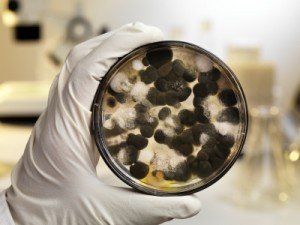Excerpts from the 1985 study about the inhalation of mycotoxins:
Swine and rats have been used to assess the effects of exposure to T-2 toxin. Acute systemic T-2 toxicosis is a cardiovascular shock syndrome characterized by reductions in cardiac output and blood pressure and increased plasma concentrations of epinephrine, norepinephrine, thromboxane B, 6-keto- PGF,9, and lactate. An initial leukocytosis is followed by a leukopenia Serum-bound calcium concentrations decrease, while magnesium, phospthorus, and potassium Increase. There was greater variation in the levels of selected cardiac bulk electrolytes of rats dosed with T-2 toxin than in control animals. In swine, myocardial, brain, renal, splenic, and pancreatic blood flow decreased, while that of the adrenals, liver, and gastrointestinal tract was increased or not affected following T-2 toxin administration.
Sublethal and/or lethal intravenous Injections of T-2 toxin produce heart and pancreatic lesions, in addition to the well-documented radiomimetic lesions. Grossly, there are subendocardial hemorrhages, pinpoint white foci in the myocardium, and pancreatic edema. Microscopic and ultrastructural changes in the heart include myofiber degeneration, vacuolization, necrosis, and mineralization with formation of hypercontraction bands. Pancreatic changes consist of acinar degeneration and necrosis which progress to a diffuse suppurative necrotizing pancreatitis.
Swine and rats were used to study toxic effects of T-2 toxin, diacetoxyscirpenol (DAS), and deoxynivalenol (DON), common trichothecene fungal toxins. According to a previous study, it was estimated that the pigs retained approximately 1/3 of the amount of nebulized toxin. Acute toxicosis from T-2 and DAS is a cardiovascular shock syndrome similar to, but distinct from, that of an endotoxin. The syndrome is similar following exposure by oral, inhalation, or intravascular routes.
The pathologic effects of T-2 toxicosis were evaluated in 8 pigs. They were administered T-2 toxin in intravenous doses of 0.0 mg/kg (2 pigs) and 0.6 mg/kg (6 pigs) dissolved in 2.5 mL of 50 percent ethanol and were killed 24 and 48 hours later. On gross examination, pancreatic edema, multifocal subendocardial hemorrhages, and pinpoint white foci were present scattered throughout the myocardium of one pig killed at 48 hours. Myofiber degeneration and necrosis with contraction bands were seen in all T-2-dosed pigs, mainly in the subendocardial region. Although the lesions were present throughout the heart, they were predominant in the atria, papillary muscles of the left ventricle and lower left and upper right ventricles. In addition, myofiber vacuolization was another morphological alteration observed in some affected muscle bundles. Vacuolization was more often detected in papillary muscles of the left ventricle. Ultrastructural changes consisted of areas of sarcoplasmic edema with myofibrillar disorganization and loss of Z and M bands, as well as glycogen accumulation in mildly affected myocytes. In severely damaged myocytes, hypercontraction bands with myofibrillar, lysis or marked distension of sarcoplasmic reticulum with myofibrillar lysis was evident.
Pancreatic changes consisted of multifocal acinar degeneration and necrosis. These changes became a suppurative necrotizing pancreatitis in the pigs killed at 48 hours. Early ultrastructual changes consisted of dilation of the membranous portion of the rough endoplasmic reticulum and disorganization, as well as mitochondrial swelling and loss of cristae.

